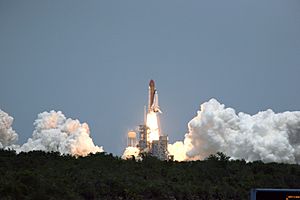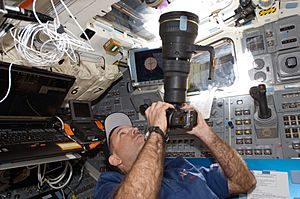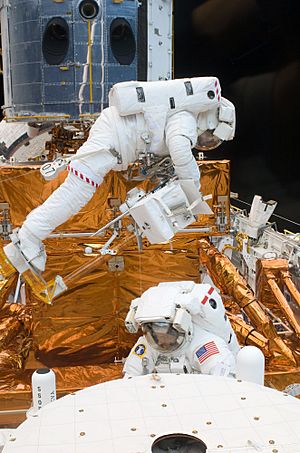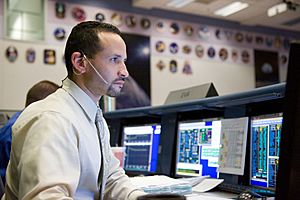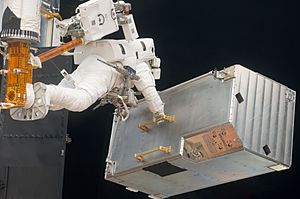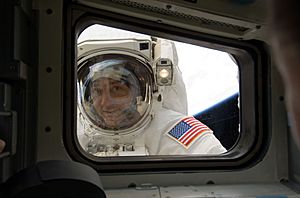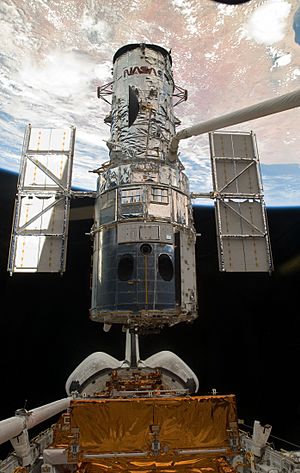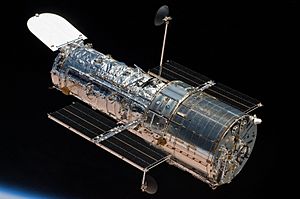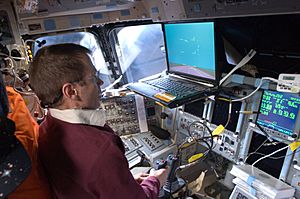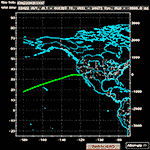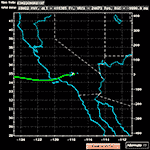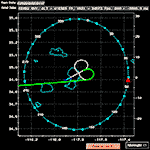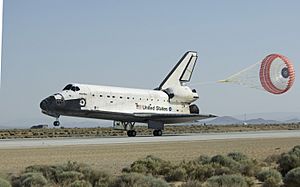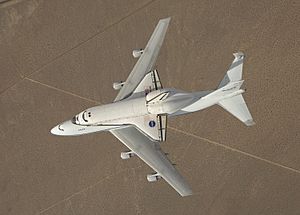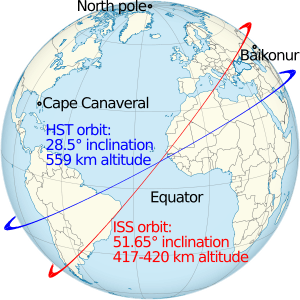STS-125 facts for kids
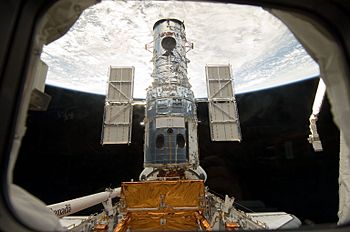
The Hubble Space Telescope in Atlantis' payload bay
|
|
| Mission type | Hubble servicing |
|---|---|
| Operator | NASA |
| Mission duration | 12 days, 21 hours, 37 minutes, 9 seconds |
| Distance travelled | 8,500,000 kilometres (5,300,000 mi) |
| Orbits completed | 197 |
| Spacecraft properties | |
| Spacecraft | Space Shuttle Atlantis |
| Crew | |
| Crew size | 7 |
| Members |
|
| Start of mission | |
| Launch date | 11 May 2009, 18:01:56 UTC |
| Launch site | Kennedy LC-39A |
| End of mission | |
| Landing date | 24 May 2009, 15:39:05 UTC |
| Landing site | Edwards Runway 22 |
| Orbital parameters | |
| Reference system | Geocentric |
| Regime | Low Earth |
| Perigee | 486 kilometres (302 mi) |
| Apogee | 578 kilometres (359 mi) |
| Inclination | 28.5° |
| Period | 97 min |
| Capture of Hubble | |
| RMS capture | 13 May 2009, 17:14 UTC |
| Berthing date | 13 May 2009, 18:12 UTC |
| Unberthing date | 19 May 2009, 11:24 UTC |
| RMS release | 19 May 2009, 12:57 UTC |
 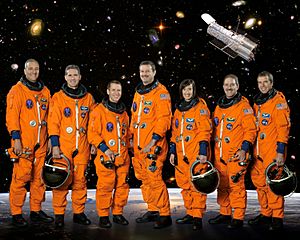 From left to right: Massimino, Good, Johnson, Altman, McArthur, Grunsfeld and Feustel |
|
STS-125 was a very important Space Shuttle mission. It was the fifth and final time a Space Shuttle visited the Hubble Space Telescope (HST). This mission was also the last time the Space Shuttle Atlantis flew by itself.
Atlantis launched on May 11, 2009, and landed on May 24, 2009. The whole trip lasted almost 13 days. The main goal was to fix and upgrade the Hubble Space Telescope. This would help it keep working and make even more amazing discoveries.
The mission added two new tools to Hubble: the Cosmic Origins Spectrograph and the Wide Field Camera 3. The crew also replaced old parts like a Fine Guidance Sensor, six gyroscopes, and two battery units. These changes helped Hubble work well until at least 2014. They also put on new thermal blankets to protect the telescope. A special "soft-capture mechanism" was added too. This would help a robot spacecraft safely guide Hubble out of orbit when it stops working in the future. The crew even filmed parts of the mission for an IMAX movie called Hubble.
Three of the astronauts on STS-125 had worked on Hubble before. Scott Altman was the commander of a Hubble mission in 2002. John Grunsfeld, who is an astronomer, had done five spacewalks on Hubble missions. Michael Massimino also did two spacewalks on a previous Hubble mission.
NASA said the mission was a huge success. All the main goals were met, and even some extra tasks were done. This made Hubble the most advanced it had ever been. The upgrades helped Hubble see even deeper into space and further back in time, almost to the Big Bang.
STS-125 was the only time Atlantis visited Hubble. Other shuttles like Discovery, Columbia, and Endeavour had serviced it before. This mission was the 30th flight for Atlantis. It was also the first time in over 14 years that Atlantis did not visit a space station.
Contents
- Meet the Crew
- Mission Story
- What the Shuttle Carried
- Shuttle Preparations
- Mission Timeline
- May 11 (Flight Day 1: Launch)
- May 12 (Flight Day 2: Checking the Shuttle)
- May 13 (Flight Day 3: Meeting Hubble)
- May 14 (Flight Day 4: Spacewalk 1)
- May 15 (Flight Day 5: Spacewalk 2)
- May 16 (Flight Day 6: Spacewalk 3)
- May 17 (Flight Day 7: Spacewalk 4)
- May 18 (Flight Day 8: Spacewalk 5)
- May 19 (Flight Day 9: Releasing Hubble)
- May 20 (Flight Day 10: Rest and Talk)
- May 21 (Flight Day 11: Landing Preparations)
- May 22 (Flight Day 12: Landing Delayed)
- May 23 (Flight Day 13: Another Delay)
- May 24 (Flight Day 14: Landing)
- After Landing
- Spacewalks (EVAs)
- Wake-up Songs
- Rescue Mission Plan
- Images for kids
- See also
Meet the Crew
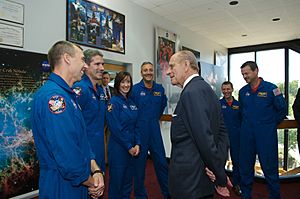
The STS-125 crew had seven astronauts. Here's who they were:
- Commander: Scott Altman (This was his fourth and last spaceflight.)
- Pilot: Gregory C. Johnson (This was his only spaceflight.)
- Mission Specialist 1: Michael T. Good (This was his first spaceflight.)
- Mission Specialist 2: Megan McArthur (This was her first spaceflight.)
- Mission Specialist 3: John M. Grunsfeld (This was his fifth and last spaceflight.)
- Mission Specialist 4: Michael J. Massimino (This was his second and last spaceflight.)
- Mission Specialist 5: Andrew J. Feustel (This was his first spaceflight.)
Mission Story
The plan for this fifth Hubble mission was first set for late 2005 or early 2006. But on January 16, 2004, the head of NASA, Sean O'Keefe, canceled it. He said it was too risky after the Columbia accident. Many people, including scientists and the media, disagreed with his choice.
Maryland Senator Barbara Mikulski spoke out against the decision. She said it went against what the science community wanted. In March 2004, Representative Mark Udall asked for experts to review the decision. Also, the Space Telescope Science Institute showed amazing new images from Hubble, proving how important it was.
NASA's Chief Scientist, physicist John Grunsfeld, was very sad about the cancellation. He had spent years working on Hubble. He looked for other ways to fix the telescope, like using robots. When O'Keefe resigned in December 2004, many hoped the mission would be back on.
The new NASA head, Michael D. Griffin, quickly said he disagreed with O'Keefe. He had worked on Hubble before and knew its value. He believed a robot mission wouldn't work. After two successful shuttle flights, NASA found a way to service Hubble safely.
On October 31, 2006, Griffin announced that the Hubble mission was back on for 2008. He also named the crew, including Grunsfeld. Senator Mikulski was very happy, saying Hubble was "the greatest telescope since Galileo invented the first one."
Astronaut Michael Massimino, a big fan of the New York Mets, brought the home plate from Shea Stadium with him on the mission. He had to change it a little to make it fit. After the mission, he gave it back to the Mets, and it's now on display at Citi Field.
What the Shuttle Carried
The Atlantis shuttle carried many important things to Hubble.
- It brought two new science tools:
* The Cosmic Origins Spectrograph: This tool is super sensitive to ultraviolet light. It helps scientists study how the universe began. * The Wide Field Camera 3: This camera can see many types of light, including infrared, visible, and ultraviolet. It takes very clear, wide pictures.
- The mission also carried the Soft-Capture Mechanism. This special device was attached to Hubble. It will allow a future spacecraft to connect with Hubble and guide it safely out of orbit when it's no longer working.
- They also brought parts to fix Hubble's existing systems. These included a new "Fine Guidance Sensor" to help Hubble point accurately, six new gyroscopes, new batteries, and new outer blankets for better insulation.
Astronauts also brought personal items and special collectibles. These included a Harlem Globetrotters basketball and a basketball that Edwin Hubble himself used in 1909! Michael Massimino also flew a copy of Galileo's Sidereus Nuncius from his old school, MIT.
IMAX Movie About Hubble
In 2007, Warner Bros. Pictures and IMAX announced they would make a 3D movie about Hubble. An IMAX 3D camera flew with Atlantis to film the mission. Another IMAX camera was at the launch site. The movie, called IMAX: Hubble 3D, came out in March 2010.
Astronauts on Social Media
Astronaut Michael J. Massimino used Twitter to share updates about the mission. He posted about his training and even sent messages from space! His first tweet from orbit said, "Launch was awesome!! I am feeling great, working hard, & enjoying the magnificent views, the adventure of a lifetime has begun!"
Shuttle Preparations
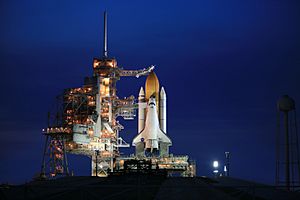
The STS-125 mission was first planned for Discovery in May 2008. But delays changed the schedule, and Atlantis was chosen instead in January 2007. The crew visited the Kennedy Space Center in July 2008 to get familiar with the shuttle and its tools.
Launch Delays
There were several delays before launch.
- In August 2008, Tropical Storm Fay and Hurricane Hanna caused delays in moving Atlantis to the launch pad.
- The launch was pushed back to October 2008 because of delays in making fuel tanks for future missions.
- On September 27, 2008, a key computer unit on the Hubble Space Telescope broke down. Because of this, NASA decided to delay the STS-125 launch until 2009. This allowed engineers to prepare a new part for the mission. Atlantis was moved back to the Vehicle Assembly Building.
- On October 30, 2008, NASA announced that Atlantis would be taken apart from its fuel tank and boosters. These parts were then used for the STS-119 mission. Atlantis was put back together with new parts in March 2009 and rolled out to the launch pad on March 31.
- The launch date was moved up one day to May 11, 2009, to give the mission a longer launch window.
Mission Timeline
May 11 (Flight Day 1: Launch)
Atlantis launched right on time at 2:01 p.m. EDT. Soon after launch, the crew opened the payload bay doors and got ready for robotic work. They used the shuttle's robotic arm to check the payload bay.
Engineers on the ground checked the launch pad. They found some damage to the flame deflector, but it was not as bad as damage from previous launches.
May 12 (Flight Day 2: Checking the Shuttle)
The crew spent the day checking the shuttle's heat shield. They used the robotic arm and a special boom (OBSS) to inspect the heat-resistant tiles. Engineers on the ground saw a small damaged area on the right wing. They told the crew that a sensor had recorded something hitting the wing during launch. They said it didn't look serious but would be checked more closely.
The crew also got the tools and spacesuits ready for the spacewalks.
May 13 (Flight Day 3: Meeting Hubble)
The crew worked to get Atlantis closer to the Hubble telescope. After some small communication issues, Commander Altman and Pilot Johnson guided the shuttle within 50 feet of Hubble. Astronaut McArthur then successfully grabbed Hubble with the robotic arm at 1:14 p.m. EDT. By 2:12 p.m. EDT, Hubble was safely placed in the shuttle's cargo bay.
Later, astronauts Grunsfeld, Feustel, Good, and Massimino prepared for the first spacewalk. They got their tools and checked their spacesuits. NASA managers said the small damage on the shuttle's wing was not a problem. They also noticed some dust around the new camera in the cargo bay, but it was not a big concern.
May 14 (Flight Day 4: Spacewalk 1)
The first spacewalk began at 8:52 a.m. EDT. Grunsfeld and Feustel went outside. Feustel checked the dust around the new camera and said it was barely there. Their first big task was to remove the old Wide Field and Planetary Camera 2 and replace it with the new Wide Field Camera 3 (WFC3). Feustel had trouble with a stubborn bolt on the old camera. After many tries, he finally got it loose.
The new camera helps Hubble take much clearer and wider pictures. After it was installed, ground control tested it, and it worked!
Next, they replaced Hubble's Science Instrument Command and Data Handling Unit. This computer sends commands to Hubble's tools. This was the part that broke in 2008 and caused the mission delay. Replacing it made Hubble more reliable.
Finally, they installed the Soft-Capture Mechanism. This will help future spacecraft connect with Hubble. The spacewalk ended at 4:12 p.m. EDT, lasting 7 hours and 20 minutes. It was the 19th spacewalk ever to service Hubble.
May 15 (Flight Day 5: Spacewalk 2)
The second spacewalk started at 8:49 a.m. EDT. Massimino and Good went outside. They replaced three of Hubble's gyroscopes. These gyroscopes help the telescope point itself. They had some trouble installing one unit, but they used a spare and got all three working. This was very important because Hubble needed these to keep pointing correctly.
They also replaced one of Hubble's old battery modules with a new one. These batteries power Hubble when it's in Earth's shadow. The spacewalk ended at 4:45 p.m. EDT, lasting 7 hours and 56 minutes. It was the 20th spacewalk for Hubble.
May 16 (Flight Day 6: Spacewalk 3)
The third spacewalk began at 9:35 a.m. EDT. Grunsfeld and Feustel went out for what was thought to be the hardest spacewalk. Their tasks were to remove the old Corrective Optics Space Telescope Axial Replacement (COSTAR) and install the new Cosmic Origins Spectrograph (COS). COSTAR was put in place to fix a problem with Hubble's mirror.
They also had to repair the Advanced Camera for Surveys (ACS). This camera had stopped working in 2006. It was not designed to be fixed in space, so this was a very tricky job. They used special tools to open the camera, replace circuit boards, and install a new power supply.
They worked very quickly and finished the spacewalk in 6 hours and 36 minutes. The ACS passed its first tests! This was the 21st Hubble servicing spacewalk.
May 17 (Flight Day 7: Spacewalk 4)
The fourth spacewalk started at 9:45 a.m. EDT. Massimino and Good worked to repair the Space Telescope Imaging Spectrograph (STIS). This tool had stopped working in 2004. Like the ACS, STIS was not made to be fixed in space.
Massimino had trouble removing a handrail because of a stripped bolt. After trying different ways, he was told to use force to break it off. He also had a power tool battery fail. Despite these problems, they finished the STIS repair. The spacewalk lasted 8 hours and 2 minutes, making it one of the longest spacewalks ever. It was the 22nd spacewalk for Hubble.
Scientists were very happy about the STIS repair. This part of Hubble helps them understand what planets are made of and how stars move around black holes.
May 18 (Flight Day 8: Spacewalk 5)
The fifth and final spacewalk began at 8:20 a.m. EDT. Grunsfeld and Feustel successfully installed the second new battery. They also replaced the third Fine Guidance Sensor, which helps Hubble focus and stay steady. They worked so well that they finished early. This gave them time to remove old insulation panels and install new ones.
The mission's last spacewalk ended at 3:22 p.m. EDT, lasting 7 hours and 2 minutes. In total, the astronauts spent 36 hours and 56 minutes outside the shuttle on this mission. This was the 23rd and final spacewalk to service Hubble.
With all the upgrades, Hubble was now more powerful than ever. It can see deeper into the universe and further back in time. Scientists believe these upgrades will help Hubble work well beyond 2014.
May 19 (Flight Day 9: Releasing Hubble)
The crew got ready to release Hubble. Astronaut McArthur used the robotic arm to lift Hubble out of the cargo bay. At 8:57 a.m. EDT, McArthur successfully released the telescope. Commander Altman confirmed that Hubble was safely back on its journey. He thanked the team, saying, "Not everything went as we planned, but we planned a way to work around everything."
After releasing Hubble, the crew checked the shuttle's heat shield one last time before landing.
May 20 (Flight Day 10: Rest and Talk)
After a busy week, the crew had most of the day off to rest. They took their official crew photo and talked to reporters. They also spoke with the crew on the Expedition 19 at the International Space Station, who congratulated them.
Later, President Barack Obama called the crew. He congratulated them on their successful mission and said he was proud of them.
May 21 (Flight Day 11: Landing Preparations)
The crew spent the day getting ready for landing. They checked the shuttle's flight controls and communications. Commander Altman and Pilot Johnson practiced landing using a simulator.
In the afternoon, the crew made history by testifying live from space to the United States Senate. Senator Barbara Mikulski and former astronaut Senator Bill Nelson spoke with them about the importance of spaceflight and fixing Hubble.
NASA managers said the weather in Florida looked bad for a Friday landing. They decided to try for a Saturday landing instead.
May 22 (Flight Day 12: Landing Delayed)
The weather in Florida was still bad with low clouds and thunderstorms. Because of this, NASA decided to delay the landing until Saturday.
May 23 (Flight Day 13: Another Delay)
On Saturday, the weather in Florida was still not good enough for landing. So, NASA decided to wait one more day and try for a Sunday landing in Florida. If that didn't work, they could land at Edwards Air Force Base in California, where the weather was good.
May 24 (Flight Day 14: Landing)
On Sunday, NASA decided the weather in Florida was too risky. They chose to land at Edwards Air Force Base in California instead. The shuttle began its journey back to Earth at 10:24 a.m. EDT.
Atlantis landed successfully at Edwards Air Force Base at 11:39 a.m. EDT. It had completed 197 orbits and traveled about 5.2 million miles. This was the last time Atlantis would land at Edwards.
After landing, the crew walked around the shuttle and met with NASA employees. Commander Altman joked, "I didn't realize it was going to be so hard to get back to the Earth!" NASA officials said the mission was a complete success.
After Landing
After landing, Atlantis was lifted onto a special Boeing 747 airplane called a Shuttle Carrier Aircraft (SCA). This plane flew Atlantis back to Florida. The journey started on June 1 and included stops for refueling. On June 2, 2009, the SCA landed at Kennedy Space Center. Atlantis was then moved to the Orbiter Processing Facility.
Spacewalks (EVAs)
The mission included five spacewalks, one after another. Each spacewalk was planned to last about six to seven hours. All five spacewalks were completed successfully. In total, the astronauts spent 36 hours and 56 minutes working outside the shuttle.
- EVA 1: John M. Grunsfeld and Andrew J. Feustel (7 hours, 20 minutes)
* They replaced the old Wide Field and Planetary Camera 2 with the new Wide Field Camera 3. * They replaced the Science Instrument Command and Data Handling Unit. * They installed a special mechanism to help future spacecraft capture Hubble.
- EVA 2: Michael J. Massimino and Michael T. Good (7 hours, 56 minutes)
* They replaced all three of Hubble's gyroscope units. * They replaced one of Hubble's battery units.
- EVA 3: Grunsfeld and Feustel (6 hours, 36 minutes)
* They removed the old COSTAR instrument. * They installed the new Cosmic Origins Spectrograph. * They repaired the Advanced Camera for Surveys by replacing faulty parts.
- EVA 4: Massimino and Good (8 hours, 2 minutes)
* They repaired the Space Telescope Imaging Spectrograph (STIS). This spacewalk was longer than planned due to some challenges.
- EVA 5: Grunsfeld and Feustel (7 hours, 2 minutes)
* They replaced the last battery unit. * They installed Fine Guidance Sensor No. 3. * They replaced old insulation panels with new ones. This was the final spacewalk to service Hubble.
Wake-up Songs
NASA has a tradition of playing music to astronauts to wake them up. Each song is chosen by the astronauts' families or has a special meaning to the crew.
- Day 2: "Kryptonite" by 3 Doors Down (for Pilot Gregory Johnson)
- Day 3: "Upside Down" by Jack Johnson (for Mission Specialist Megan McArthur)
- Day 4: "Stickshifts and Safetybelts" by CAKE (for Mission Specialist Andrew Feustel)
- Day 5: "God of Wonders" by Third Day (for Mission Specialist Michael Good)
- Day 6: "Hotel Cepollina" (a parody of Hotel California) by Fuzzbox Piranha (for Mission Specialist John Grunsfeld)
- Day 7: "New York State of Mind" by Billy Joel (for Mission Specialist Michael Massimino)
- Day 8: "Sound of Your Voice" by Barenaked Ladies (for Commander Scott Altman)
- Day 9: "Lie in Our Graves" by Dave Matthews Band (for McArthur)
- Day 10: "Theme from Star Trek" by Alexander Courage (for the whole STS-125 Crew)
- Day 11: "Cantina Band" by John Williams (for the whole STS-125 Crew)
- Day 12: "Galaxy Song" from the movie Monty Python's The Meaning of Life (for the whole STS-125 Crew)
- Day 13: "Where My Heart Will Take Me" (Theme from Star Trek: Enterprise) by Russell Watson (for the whole STS-125 Crew)
- Day 14: "Ride of the Valkyries" by Richard Wagner (for the whole STS-125 Crew)
After their final wake-up call, the Atlantis crew played "Take Me Home" by Phil Collins for the Mission Control team. This was a thank you for all their hard work during the mission.
Rescue Mission Plan
STS-125 was the only shuttle mission after the Columbia accident that could not reach the International Space Station. This was because Hubble's orbit was different from the Space Station's. So, if Atlantis had a major problem, it couldn't go to the Space Station for safety.
To be safe, NASA had a rescue mission ready called STS-400. The Endeavour shuttle was prepared to launch and rescue the Atlantis crew if needed. After Atlantis was checked and cleared for re-entry, Endeavour was officially released from its standby duty on May 21.
Images for kids
See also
 In Spanish: STS-125 para niños
In Spanish: STS-125 para niños



